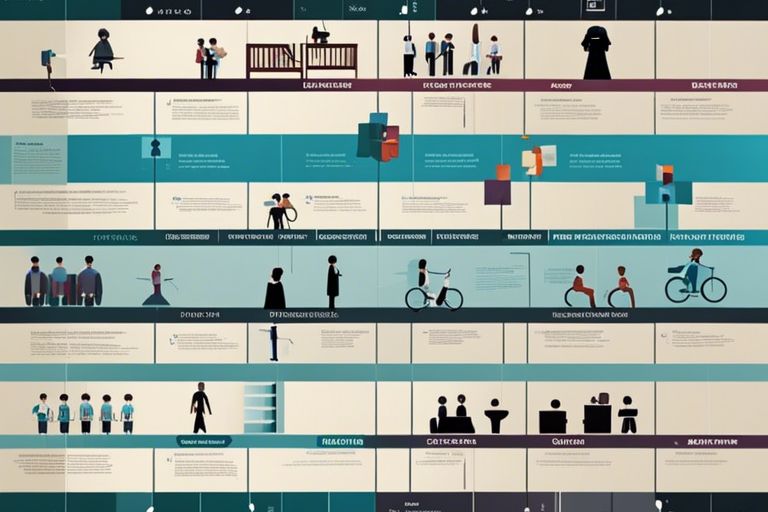Autism, a complex neurodevelopmental disorder, has a long and evolving history regarding its diagnosis. The term ‘autism’ originates from the Greek word ‘autos’, meaning ‘self’, and was first used by psychiatrist Eugen Bleuler in 1911. However, it was not until 1943 that Dr. Leo Kanner introduced the term ‘infantile autism’ to describe a specific set of behaviours he observed in children. Over the years, our understanding of autism has significantly progressed, leading to earlier and more accurate diagnoses. Despite this progress, misconceptions, stigma, and lack of support continue to pose challenges for individuals with autism and their families. It is crucial to investigate into the history of autism diagnosis to learn from the past and strive towards a more inclusive and supportive future for those living with autism.
Key Takeaways:
- Autism was first identified in the early 20th century: The diagnosis of autism can be traced back to the early 20th century when researchers began to identify certain behavioural patterns and characteristics in children.
- Leo Kanner and Hans Asperger played key roles: Leo Kanner and Hans Asperger were two pioneering researchers who independently described the characteristics of autism in children, leading to the recognition of autism as a separate condition.
- Understanding and diagnosing autism has evolved over time: The understanding and diagnosis of autism have evolved significantly over time, with changes in diagnostic criteria, increased awareness, and ongoing research contributing to a better understanding of the condition.
Early Observations and Theories
Throughout history, there have been accounts of individuals displaying characteristics that are now associated with autism. Pre-20th Century beliefs often misunderstood these behaviours, attributing them to various causes such as demonic possession or divine punishment. In ancient texts, descriptions of people exhibiting repetitive behaviours, social difficulties, and communication challenges can be found, although they were not labelled as autism at the time.
Pre-20th Century Accounts
Early accounts of autism-like behaviours can be traced back to ancient civilisations such as the Ancient Greeks and Romans. However, these observations were often interpreted through a lens of superstition or myth rather than scientific understanding. For example, in ancient Greek texts, individuals with characteristics resembling autism were sometimes believed to be under the influence of malevolent spirits or cursed by the gods.
Eugen Bleuler and the Origin of the Term
The term ‘autism’ was first introduced by Swiss psychiatrist Eugen Bleuler in the early 20th century. Bleuler used this term to describe a symptom of schizophrenia, referring to a withdrawal from reality and social engagement. It was not until later that researchers such as Leo Kanner and Hans Asperger redefined and expanded the concept of autism to what we understand today.
Eugen Bleuler’s contribution to the field of psychiatry was significant, as his work helped pave the way for a greater understanding of the complexities of mental illness, including autism. His term ‘autism’ laid the groundwork for further research and identification of the characteristics associated with the spectrum.

The Diagnostic Evolution
In tracing the history of autism diagnosis, it is crucial to understand the key figures and milestones that have shaped the evolution of this complex disorder. From the pioneering work of Leo Kanner to the contemporary understanding of the autism spectrum, the diagnostic criteria and perceptions surrounding autism have undergone significant transformations over the years.
Leo Kanner and First Clinical Definition
Leo Kanner, an Austrian-American psychiatrist, is widely regarded as the pioneer of autism diagnosis. In 1943, Kanner published a groundbreaking paper introducing the concept of ‘early infantile autism’. He described a group of children who displayed social withdrawal, communication difficulties, and repetitive behaviours, laying the foundation for the first clinical definition of autism.
His work revolutionised the understanding of autism, highlighting the distinct characteristics of the condition and challenging prevailing beliefs. Kanner’s emphasis on the role of genetics and neurological factors in the development of autism set the stage for further research and diagnostic advancements in the field.
Hans Asperger and the Autism Spectrum
Hans Asperger, an Austrian paediatrician, made significant contributions to the understanding of autism with his work on what is now known as Asperger’s syndrome. In 1944, Asperger described a milder form of autism in children who exhibited social difficulties and repetitive behaviours but demonstrated exceptional abilities in specific areas.
Asperger’s recognition of a wider spectrum of autistic traits helped broaden the conceptualisation of autism beyond Kanner’s initial definition. His research highlighted the diverse ways in which autism can manifest, paving the way for the contemporary understanding of autism as a spectrum disorder.
Asperger’s observations of ‘high-functioning’ individuals with autism challenged the prevailing notion that all autistic individuals were severely disabled, emphasising the unique strengths and challenges present across the spectrum.

The Rise of Modern Understanding
The DSM Milestones
The Diagnostic and Statistical Manual of Mental Disorders (DSM) has played a crucial role in shaping our understanding of autism. The milestones in the history of autism diagnosis within the DSM are significant. In 1980, the DSM-III included ‘Infantile Autism’ as a distinct category for the first time, separate from childhood schizophrenia. This recognition helped differentiate autism as a unique condition and led to increased research and understanding.
In 2013, the DSM-5 introduced major changes by merging several different diagnoses, including Asperger’s syndrome and pervasive developmental disorder not otherwise specified (PDD-NOS), into the umbrella term ‘Autism Spectrum Disorder’ (ASD). This shift reflected the evolving understanding that autism exists on a spectrum, with varying degrees of severity, and highlighted the importance of early intervention and individualised support.
Contemporary Views on Autism
Contemporary views on autism have evolved to embrace a more inclusive and person-centred approach. Rather than focusing solely on deficits, the emphasis is now on celebrating neurodiversity and recognising the unique strengths and abilities of individuals on the autism spectrum. This paradigm shift has led to a greater appreciation of the diversity of experiences within the autism community and a move towards promoting acceptance and support.
With advances in research and advocacy, there is now a growing recognition that autism is not a tragedy to be ‘cured’ but a different way of experiencing the world. The emphasis is on providing appropriate accommodations and creating inclusive environments that allow individuals with autism to thrive and contribute their unique perspectives to society.
Contemporary views on autism promote neurodiversity, celebrating the unique strengths and abilities of individuals on the autism spectrum, while highlighting the importance of creating inclusive environments and providing appropriate accommodations for their needs.
Socio-Cultural Impact
Public Perception Shifts
In recent years, there has been a noticeable shift in public perception towards autism. What was once misunderstood and stigmatised is now increasingly recognised and accepted in society. Media representation and awareness campaigns have played a crucial role in this change, shedding light on the diverse experiences of individuals on the autism spectrum.
Education and advocacy efforts have also contributed to changing attitudes towards autism. By highlighting the strengths and unique perspectives of people with autism, the narrative has shifted from one of deficit to one of diversity and inclusion.
Policy and Advocacy Developments
Policy and advocacy developments in the field of autism have significantly improved the lives of individuals on the spectrum. Legislation aimed at protecting the rights of people with autism, such as access to healthcare, education, and employment opportunities, has been crucial in advancing their well-being. Advocacy groups have been instrumental in pushing for these changes and ensuring that the voices of those with autism are heard at all levels of decision-making.
Research has also played a key role in shaping policy and advocacy efforts for autism. By providing evidence-based insights into effective interventions and support services, research has helped drive positive changes in how autism is understood and addressed in society.
Research Advances and Future Directions
Genetic and Environmental Studies
Recent research in autism has increasingly focused on investigating the interplay between genetic and environmental factors in the development of the condition. Studies have identified various genetic markers that may predispose individuals to autism, shedding light on the complex nature of the disorder. Additionally, research has highlighted the potential impact of environmental factors such as prenatal complications, exposure to certain toxins, and maternal health on the risk of autism.
Advancements in technology have enabled researchers to investigate deeper into the genetic underpinnings of autism, opening up new avenues for targeted interventions and treatments. By understanding the intricate balance between genetic susceptibility and environmental influences, scientists aim to develop personalised approaches to support individuals with autism and enhance their quality of life.
Innovations in Autism Therapy and Support
Therapeutic interventions for autism have undergone significant advancements in recent years, with the development of innovative approaches tailored to meet the diverse needs of individuals on the spectrum. Techniques such as behavioural therapy, speech and language therapy, and social skills training have shown promising results in improving communication, social interactions, and behavioural patterns among individuals with autism.
The use of technology, including virtual reality and interactive apps, has revolutionised the delivery of therapy for individuals with autism, providing engaging and immersive experiences to promote skill development and learning. These innovative tools have the potential to transform traditional therapy approaches and enhance the effectiveness of interventions for individuals with autism.
Moreover, collaborative efforts between researchers, clinicians, and individuals with autism and their families are crucial for driving forward innovations in therapy and support services. By working together, stakeholders can co-create tailored interventions that address the unique challenges faced by individuals on the autism spectrum, ultimately improving outcomes and quality of life.

Conclusion: Tracing the Origins of Autism Diagnosis
Through centuries of medical advancements, the understanding and diagnosis of autism have evolved significantly. From ancient references to modern scientific breakthroughs, the concept of autism has come a long way. The history of autism diagnosis is a testament to the progress made in recognising and supporting individuals on the autism spectrum. By delving into its origins, we gain valuable insights into the complexity of this condition and the importance of ongoing research and awareness. As we continue to unravel the mysteries surrounding autism, it is crucial to appreciate the journey that has brought us to our current understanding, paving the way for more informed approaches to support those with autism in our society.
FAQ
Q: What is autism and where did it originate?
A: Autism is a neurodevelopmental disorder characterized by difficulties in social interaction and communication, as well as restricted and repetitive behaviour. The concept of autism originated in the early 20th century.
Q: Who first identified autism as a medical condition?
A: Autism was first identified as a medical condition by psychiatrist Leo Kanner in 1943. He published a groundbreaking paper describing 11 children with what he termed “early infantile autism.”
Q: How has our understanding of autism evolved since it was first identified?
A: Our understanding of autism has evolved significantly over the years. What was once thought to be a rare condition caused by poor parenting is now recognised as a complex spectrum of disorders with a strong genetic basis.
Q: When did the term “autism” come into common usage?
A: The term “autism” came into common usage in the 1960s as researchers began to distinguish it from other developmental disorders. It was later included in the diagnostic criteria for autism spectrum disorder.
Q: What are some key milestones in the history of autism diagnosis?
A: Some key milestones in the history of autism diagnosis include the recognition of Asperger’s syndrome by Hans Asperger in the 1940s, the inclusion of autism in the DSM-III in 1980, and the development of the concept of the autism spectrum.
Q: How has the prevalence of autism changed over time?
A: The prevalence of autism has increased significantly over the past few decades, which is partly due to improved diagnostic criteria and increased awareness. It is now estimated that around 1 in 54 children are diagnosed with autism spectrum disorder.
Q: What can be done to support individuals with autism today?
A: Today, there is a greater focus on early intervention, behavioural therapies, and support services to help individuals with autism lead fulfilling lives. It is important to promote acceptance, understanding, and inclusivity for people on the autism spectrum.







